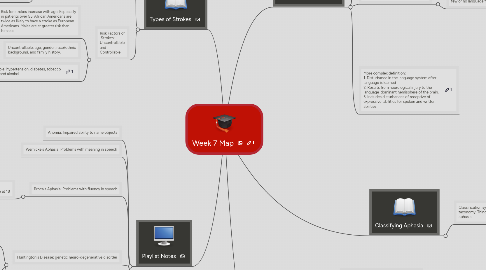
1. Types of Strokes
1.1. Stroke: Caused when a clot in the brain disrupts blow flow to the brain; thus, robbing the brain tissue of oxygen needed to properly function
1.1.1. Ischemic strokes: Blood supply to the brain is inhibited because of a blockage in an artery. Occur because of thrombosis or an embolism.
1.1.1.1. Thrombosis: Plaque builds up in artery and closes it off, prohibiting blood flow
1.1.1.2. Embolism: Piece of accumulated plaque breaks off and artery and migrates to smaller arteries where is lodges and blocks blood flow.
1.1.2. Hemorrhagic stroke: Blood vessel or artery ruptures and excessive amounts of blood enter the brain
1.2. Risk Factors of Strokes: Uncontrollable and Controllable
1.2.1. Risk for strokes increase with age. Especially in patients over 55. African Americans are twice as likely to have a stroke as European Americans. Males are at greater risk than females
1.2.2. Uncontrollable: age, gender, race/ethnic background, and family history.
1.2.3. Controllable: hypertension, diabetes, tobacco smoking, and alcohol
2. Playlist Notes
2.1. Anomia: Impaired ability to name objects
2.2. Wernicke's Aphasia: Problems with meaning in speech
2.3. Broca's Aphasia: Problems with fluency in speech
2.3.1. Sarah Scott videos suffered Ischemic stroke at 18
2.3.1.1. Still had problems with reading and writing sentences. One word was fine. Also had problems with keeping track of money. Can't text or chat on Facebook easily. Alcohol and sleepiness negatively affect her speech abilities
2.3.1.2. Was able to re learn a certain amount of her language abilities. And re-enter society in a semi-normal way. She took driving lessons, rode horses, got a job, and was able to wean herself off of writing down her thoughts before saying them.
2.4. Huntington's Disease: genetic neuro-degenerative disorder
2.4.1. Dominantly transmitted disease. Average onset age is 40 No cure
2.4.2. Symptoms: Cognitive Impairement, mood disorders, behavioral changes, involuntary movements
2.4.3. Meghan's Story: Diagnosed with juvenile onset HD in 2007
2.4.3.1. Her father, John Sullivan, also had HD and died in 2008
2.5. Dementia and Alzheimers
2.5.1. Grace: excerpts from movie about her progression through dementia. In beginning was able to sing all of "Jesus love me", in middle was only able to say a few words, by the end she did not recognize the song.
2.5.2. Singing for the Brain: Patients with Alzheimers or Dementia. Patients find singing very freeing and therapeutic. They are able to be like everyday people again.
2.5.2.1. The breathing, the relaxation, and the articulation all benefit the patients
3. Aphasia Description
3.1. Language disorder that is acquired after language competence is developed
3.1.1. Language abilities in left hemisphere of brain for most people Small percentage of people have lang. abilities in right hemisphere
3.2. Common causes of neurological damage to the lang-dominant hemisphere: stroke, meningitis, encephalitis, tumors, toxin/poison exposure, or nutritional/metabolic disorders
3.2.1. Strokes produce most aphasias. Also, referred to as CVAs (cerebrovascular accident)
3.2.1.1. Occur when blood supply to the brain is interrupted by a clot (blood or other) in an artery that serves the brain
3.2.1.1.1. Aphasia occurs from this when the interruption damages tissue in the language areas of the brain
3.3. Literally means "absence of language"
3.3.1. Aphasia patients exhibit broad range of language difficulties: range from mild deficits to few or no language functions
3.3.1.1. The affects of aphasia on a patient are influenced by the patient's health, emotional well-being, occupational/educational achievement, and language abilities
3.3.1.2. Patients are usually adults; however, can be found in children/adolescents that have suffered strokes
3.3.1.3. NOT a psychiatric problem
3.3.1.3.1. Schizophrenia or delirium may cause some language problems
3.3.1.4. NOT a motor speech disorder
3.3.1.4.1. Dysarthia: Motor speech disorder that is causes disruptions in range, speed, direction, timing, and strength in the movements in respiratory, phonatory, articulatory, or resonatory components of speech.
3.3.1.4.2. Apraxia: Causes difficulty in planning and executing the volitional movements of speech
3.4. More complex definition: 1. Disturbance in the language system after language is learned 2. Results from neurological injury to the language-dominant hemisphere of the brain. 3. Includes disturbances of receptive of expressive abilities for spoken and written abilities
4. Types of Aphasia
4.1. Broca's Aphasia Nonfluent, effortful articulation, speaking in mostly nouns and verbs (telegraphic), short phrases, impaired prosody, apraxia of speech
4.2. Transcortical Motor Aphasia Nonfluent, problems initiating speech, paraphasias, short utterances, good repetition
4.3. Wernicke's Aphasia Fluent, meaningless speech and jargon, paraphasias, naming difficulties
4.4. Transcortical Sensory Aphasia Fluent, meaningless speech and jargon, paraphasias, naming difficulties
4.5. Conduction Fluent, imitation problems, naming difficulties, normal prosody and articulation
4.6. Anomic Fluent, loss of words
5. Classifying Aphasia
5.1. Classification system for Aphasia is called taxonomy. Things affected by types of aphasia
5.1.1. Behavioral Symptoms:
5.1.2. Fluency:
5.1.3. Motor Output
5.1.4. Language Comprehension
5.1.5. Repetition
5.1.6. Naming
5.1.7. Reading and Writing
